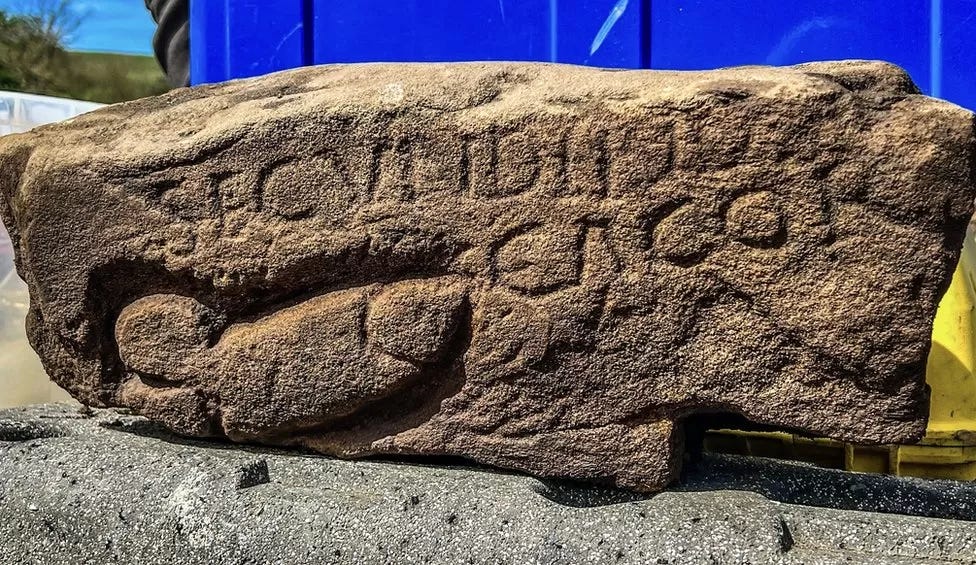Unruly History in the News #20
Better known as "The Week Everyone Talked About Ancient Rome for Some Reason"
Hi everyone,
I drove from DFW to LA this week and got to see parts of the US I’d never seen before, including the Instagram-famous Antelope Canyon (more importantly, Antelope Canyon is also sacred to the Navajo people). The American Southwest is really beautiful! I feel very lucky to have passed through there and picked up a little bit of history on the journey. I was especially excited to visit the International UFO Museum and Research Center; I jotted down a few names of people to cover on the podcast in the future.
Speaking of which, I realize it’s been a while since we’ve had a new episode. February and March have really gotten away from me, but I’m finally starting to catch up on my workload and will have a new episode on Tuesday this coming week! I also will finally have our first interview coming up soon too, so keep an eye out for that.
All right, without any further ado: This week, in history acting unruly in the news…
Since I was just at the International UFO Museum, I’m newly obsessed with this history of how humans have pictured life on Mars.
In the category of, ‘what Roman thing will we have questions about next…’
Decipher these Roman scrolls and you could win $1 million! Good luck, the scrolls were damaged by the eruption of Mount Vesuvius. And by “damaged” I mean “carbonized almost beyond recognition.” That said, someone has already gotten started, so the contest is not impossible.
Have we already talked about the 2nd-century sex toy found at Hadrian’s Wall? Because I just learned that the men who initially found it thought it was a sewing implement for a long time. Which I think tells us more about modern men than it does about ancient Roman women.
And because teenagers will be teenagers no matter the time period, historians deciphered some ancient Roman graffiti at Hadrian’s Wall and probably had a good laugh. “Secundinus cacator” translates into English as "Secundinus, the shitter,” and was carved next to a large phallus, which researchers believe added "to the force of the written insult." (Quoted in the article.) I’m sure Secundinus was less amused.

Image from the Vindolanda Trust. Source. A late Roman-Era piece of silver found in Diss, Norfolk has left experts baffled. They’re currently asking anyone and everyone for help. I guess it’s a good week to be a Roman mystery.
Under some shops in Colchester, England, a beautiful Roman mosaic is being revealed, cleaned, and displayed under glass. It was initially found in the 1980s and then reburied.
For generations, it’s been free to see the Roman Pantheon. But this 2,100-year-old site needs care and upkeep, and to afford that, the Roman government is going to start charging a €5 entrance fee. Unclear when the fee will go into effect, but I imagine soon-ish. It will still be free to attend Mass there, however.
How the Ancient Romans cared for their veterans is worth considering in comparison to the US’s poor history.
Uncovering the lost secrets of Roman roads.
Beneath an Aldi in Olney a Roman mosaic has been discovered! It was likely part of a vill and bathhouse and remains “remarkably vibrant.”
In Singapore, Sentosa Island has been a pirate haven, a military complex, a POW camp, and now it’s a… family vacation getaway? But Singapore’s government isn’t trying to whitewash this grim past; plans are underway to create educational experiences that cover “death island’s” history.
Speaking of troubling histories: This week Berlin held a ceremony to bury the bone fragments of at least 54 victims of Nazi torture and experimentation.
This isn’t unruly but, if you don’t know much about the holy month of Ramadan, now is a good time to learn!
The Met—like many other museums—is always reconsidering its collections as times change. Right now, the Met is reclassifying some art from “Russian” to “Ukranian.” It’s an important distinction, especially now.
What fresh hell is ‘blood cleaning’ and why does it sound like something Nazis are cheering in their graves about? (Turns out it might maybe help people with Long COVID, but the name is bad.)
Queen Beyoncé said it best: Who runs the world? Girls. And now world history is backing her up.
Several coins, a ring, and a belt buckle were uncovered at eight sites across Wales and declared official treasures this week. The threshold for treasure status, by the way, is: 300+ years old and contains at least 10% precious metal. (I’m pretty sure this definition only applies to metal objects found in the ground and not your personal treasured mementos.)
The headline for this story mentioned one skeleton and 12 million British pounds, but the story revealed that an astonishing 240 skeletons!!! have been found underneath a department store in Wales. They believe the skeletons are connected to a medieval priory which once stood on the site.
Brazil’s “other” rainforest is filled with glowing mushrooms. BRB, I have to plan a trip.
And speaking of incredible nature, a tour of the Korean Demilitarized Zone on Google Maps is absolutely worth your time. Untouched by humans for decades, it is a truly lovely site.

You can now use Google Maps to see the Hantan River. Image: Google Arts & Culture / DMZ Botanic Garden. Source.
Y’all, I love an illustrated timeline. And this one using 100 archaeological treasures to help you envision our shared past is just, *a chef’s kiss.*
Emperor Nero—infamous for watching Rome burn—also infamously ate the last stalk of silphion in existence…or so we thought. Once revered as a miracle plant that cured everything and tasted good, archaeologists thought silphion had been eaten out of existence 2,000 years ago. But now, we might be close to resurrecting it.
The gorgeously painted Tito Bustillo Cave was discovered accidentally by Spanish spelunkers, but it is one of the most beautiful artistic records of the Paleolithic peoples who occupied it for 26,000 years.
If you’ve been on the internet as long as I have, you’ve probably fallen down the rabbit hole of the Dyatlov Pass mystery. 9 experienced hikers died while crossing the Ural Mountains in Russia in 1959, and the inexplicable injuries their bodies suffered have inspired wild conspiracy theories for years. Now scientists may have figured out what really happened—and they used Disney’s Frozen and Ford Motor’s old research with cadavers for seat belts to do it.
The French have a long and glorious history of protesting… and an equally long history of police violence at protests. This week the French police violently cracking down on protestors were unfavorably compared to the Nazi SS, and it wasn’t the first time.
This is a very cool depiction of how King Tut was examined in his sarcophagus. It is sort of interactive, showing step-by-step how the mummy was uncovered and the treasures cataloged over seven cautious days.
Speaking of Ancient Egypt, some very beautiful pharaoh-sphinx sculptures were just unearthed from an Egyptian sun temple.
Also, 2,200-year-old zodiac paintings inside the ancient Temple of Esna are seeing the light of day after being cleaned for the first time in, well, probably about 2,000 years.

Here we see Sagittarius in the Temple of Esna. Photo by Ahmed Emam/Ministry of Tourism and Antiquities. Source.
Researchers have gotten ahold of Beethoven’s DNA, and it might shed some light on his death, as well as his early-onset deafness. It does not address the “question” of Beethoven’s race.
That said, the University of Alberta has put out a statement about whether or not Beethoven was Black that is worth a read if that meme on Twitter intrigued you.
A Celtic fertility figure was found in a field and sold at auction for £2,200.
The American Christian practice of taking the Bible as the literal word of God is a relatively new idea. Now we have a translation of the earliest known Latin commentary on the Bible, which shows that early Christians understood many Bible stories as allegorical.
This story about Sri Lanka’s history of crisis and the current potential for unity is very worth reading.




